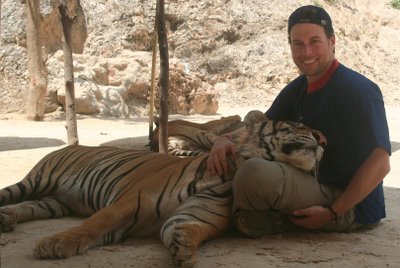Buddhaful Bengals
 (Nap time in the mid-day heat.)
(Nap time in the mid-day heat.)Walking into Tiger Canyon, my senses were on high alert, relying mostly on my eyes and ears to determine if I was being watched or worse yet, stalked. Ten minutes earlier I signed the liability release, waiving all rights to complain of an impromptu mauling. An hour past mid-day, I felt like I was under god's magnifying glass, the recipient of extra powerful sun rays compounded by oppressive humidity. Even if the tigers didn't get me, the sun and heat would.
With no tree cover in sight for the entire walk into the canyon, the end of the jaunt provided a welcome visual for relief, a large pond.
 Only problem was, there were already swimmers using the pool and the two of them combined weighed over 1,000 pounds with skin piercing claws and razor sharp teeth. Proceeding with caution, I moved in for a closer look. No fence or cage between me and the Bengals, I relied solely on the confidence of the monk seemingly in command of the big cats. 200 kilometers outside of Bangkok, I was a long way from advanced medical care.
Only problem was, there were already swimmers using the pool and the two of them combined weighed over 1,000 pounds with skin piercing claws and razor sharp teeth. Proceeding with caution, I moved in for a closer look. No fence or cage between me and the Bengals, I relied solely on the confidence of the monk seemingly in command of the big cats. 200 kilometers outside of Bangkok, I was a long way from advanced medical care. If you're scratching your head wondering why wild tigers were under the command of a monk, you are not alone. Tiger Temple, as it is commonly referred, is a buddhist monastery in central Thailand whose adopted purpose is intent on rescuing injured or orphaned wild animals, the most notorious being 18 Bengal tigers. Some of the tigers were rescued from the black market, others were injured by poachers and some were orphaned as cubs when their mothers were murdered by poachers.
Run by four monks and 15 staff members to assist their growing number of feline residents, visitors have the rare opportunity to get up close and personal with the 400-800 pound magnificent cats. Started by circumstance more than design, the first tiger, rescued from the black market, arrived at the temple in 1999. Chao Phayu ("Thunderstorm") was ordered to be stuffed by a Bangkok resident, but a boatched taxidermy procedure gave Thunderstorm another chance. Since then, the monastery has earned widespread acclaim, including a spot on Animal Planet, for its work not only on rescuing, but managing the lifetime care for the animal, no small feat when working with a cat whose swift paw swipe could shred a man in a second (just ask Roy of Siegfried & Roy).
Tigers receive medical attention and/or nursing upon arrival at the monastery, but after receiving such care and interacting with humans, they are no longer capable of survival in the wild. This has resulted in the need for more space with the growing number of rescuees so the monks now plan to build a larger reserve suitable for porper caring and housing of the tigers, water buffalo, antelope, peacocks and numerous other animals in need of a place to crash out of harm's way. Presently, there is a fundraising effort underway to raise money for a new home for the tigers establishing a more natural forest environment and a rehabilitation facility.
Early on, the monks had a steep learning curve, determining how to care for and handle the wild cats. Seven years later, the monastery has developed a regimen that balances the need to control the tigers yet not quash the animal's true nature.
 An intricate dance of dominance, not showing fear, knowing when to walk away permitting the tiger to save face and feeding the tigers cooked food so they do not taste blood (helpful if the monks want to keep their blood) keeps the tigers in check. It is a case of strange bed fellows to be sure, peaceful non-violent monks caring for wild animals whose instincts are to kill large mammals for food.
An intricate dance of dominance, not showing fear, knowing when to walk away permitting the tiger to save face and feeding the tigers cooked food so they do not taste blood (helpful if the monks want to keep their blood) keeps the tigers in check. It is a case of strange bed fellows to be sure, peaceful non-violent monks caring for wild animals whose instincts are to kill large mammals for food.Add to the mix that the monks have opened the monastery to visitors for four hours a day. Without sticks, guns, knives, poles or any other disciplinary tools, the main monk, assisted by the staff, carefully navigate animal lovers amongst the tigers. Gripped by the forearm, my guide moved slowly but steadily into the field of tigers lazing about and frolicking in the pond. Before entering the monastery, I was given a dark blue shirt to cover my redish/orange t-shirt in an abundance of caution to avoid provoking the cats (I guess this means they are not color blind).
On approach to my first tiger, the heat, oppressive and stifling before, vanished. My sole focus was on the cat panting before me. Not immune to the heat himself, a warm mid-day nap in the shade of an umbrella was on his agenda. I knelt beside him and placed my hand on his side, stroking his fur lightly so as not to disturb his rest, the consequences of which had the potential for a grumpy tiger and although I did not know what that would entail, I didn't want to find out.
After just a few minutes with the tigers, I was escorted out of the immediate tiger vicinity. But my thirst for interaction with cats was not quenched. Round two began with my request to have a picture with the lead monk who was surveying the tigers.
 I'm not sure what was translated to him, but moments later he pointed for me to kneel beside a tiger. He knelt on the other side of the tiger's head and placed the tiger's head in my hands. Petting the back of the tiger's neck felt surreal, but even more surreal was where his head found a place to rest, on my lap. As he drifted off to sleep I couldn't stop smiling in awe of the cats peacefulness, all the while mindful of his awesome strength.
I'm not sure what was translated to him, but moments later he pointed for me to kneel beside a tiger. He knelt on the other side of the tiger's head and placed the tiger's head in my hands. Petting the back of the tiger's neck felt surreal, but even more surreal was where his head found a place to rest, on my lap. As he drifted off to sleep I couldn't stop smiling in awe of the cats peacefulness, all the while mindful of his awesome strength.Sadly, the Bengal tigers, like the other remaining five species of tiger are greatly endangered. There are fewer than 2,000 left in the wild and poaching still takes place in the remote regions of Burma, Laos and Thailand. The tiger's body parts are purportedly used in Chinese medicine ranging from painkillers to aphrodisiacs. Already, three tiger species were lost in the 20th century to poaching. Tiger Temple is hoping to prevent a similar fate for the Bengal.
 (Shhh. Tiger sleeping.)
(Shhh. Tiger sleeping.) (For more information on how to visit or donate to the Tiger Temple project, visit www.tigertemple.org or www.tigertemple.com, be sure to click on the "English" version unless your Thai is up to par.)
(For more information on how to visit or donate to the Tiger Temple project, visit www.tigertemple.org or www.tigertemple.com, be sure to click on the "English" version unless your Thai is up to par.)Roopa Update: I receive almost daily inquiries about Roopa's health from many well-wishers. I am happy to report that thus far, treatment is going very well. In addition, Roopa has a lot to be excited about as her daughter, Simran, has recently been engaged to a family friend. The wedding date is set for January 23, 2007 so it looks like I'll be going back to India. Keep up the prayers and positive energy, it all seems to be moving Roopa in a healthy direction.
Happy Mother's Day to my Mom and all the Mom's in the world. A mother is the endless fountain of love from which the river of a child's soul can flow freely. The older I get, the more I appreciate the challenges of motherhood, requiring tireless patience and energy to raise good people. In large part, the fate of the world depends on good mothers raising mindful, conscious, loving, compassionate and respectful children.
(Note: On Monday, May 15, I am heading into China. I have been told that internet access is unreliable and heavily blocked so I will add new entries as permitted. My initial itinerary sets course for Guilin, in southern China.)


<< Home